 It has been exciting to have a full week of school. It’s been a busy one. We chose a name and date for our classroom museum. We’re creating our museum displays. We’ve begun a study of global geography. We used this theme, combined with the “Choose Kind” initiative at NHS, to decorate our door – “3E is spreading kindness every step of the way.”
It has been exciting to have a full week of school. It’s been a busy one. We chose a name and date for our classroom museum. We’re creating our museum displays. We’ve begun a study of global geography. We used this theme, combined with the “Choose Kind” initiative at NHS, to decorate our door – “3E is spreading kindness every step of the way.”
Our Inquiry Wonderland
This week we brainstormed a list of possible names for our museum. After a few days of voting for top fives, threes and then our final choice, we decided upon the name: Our Inquiry Wonderland. We also decided to add the by-line: Please, please come to our wonder-full museum to learn information you didn’t know before. It was an interesting process of compromise and negotiation.
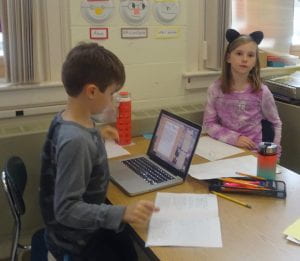 We also chose the date and times for this event. There was no perfect time for everyone, but we hope that with advance notice, families might be able to rearrange scheduled events so that everyone is able to attend. The class decided they could all be ready to present the information on Tuesday, January 14. We’ll have our museum open that afternoon for a dress rehearsal and then again between 5:30 and 6:15. We hope all the children will be able to attend and that families will tour the Inquiry Wonderland, asking each of the children to share what they have learned. The children will share their research and talk about what inspired them to select their topic.
We also chose the date and times for this event. There was no perfect time for everyone, but we hope that with advance notice, families might be able to rearrange scheduled events so that everyone is able to attend. The class decided they could all be ready to present the information on Tuesday, January 14. We’ll have our museum open that afternoon for a dress rehearsal and then again between 5:30 and 6:15. We hope all the children will be able to attend and that families will tour the Inquiry Wonderland, asking each of the children to share what they have learned. The children will share their research and talk about what inspired them to select their topic.
The goal of this project was to help children learn more about using a variety of information sources, to learn note-taking strategies and to be able to organize their information around subtopics to begin learning about paragraphing. In addition, they are learning to draft and revise their writing and to choose images that illustrate the main ideas.
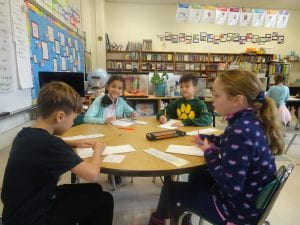 When you come to the museum, you’ll see a wide variety of presentations. We’ve allowed and encouraged the children to work independently. We talked about final presentation and the need to attention to accuracy, details and conventions. Some children have been engaged throughout the whole process. They selected a topic they wanted to understand and learn more about. Others chose a topic they felt they already knew and did little new research. Some of the children have asked for teacher support for every step, while others have chosen to work with peer support. It is interesting to see how each child works through this learning process in his or her own unique way. There is a lot to attend to in a project like this and we will be able to see how they children learn from their choices when we move on to the next research project.
When you come to the museum, you’ll see a wide variety of presentations. We’ve allowed and encouraged the children to work independently. We talked about final presentation and the need to attention to accuracy, details and conventions. Some children have been engaged throughout the whole process. They selected a topic they wanted to understand and learn more about. Others chose a topic they felt they already knew and did little new research. Some of the children have asked for teacher support for every step, while others have chosen to work with peer support. It is interesting to see how each child works through this learning process in his or her own unique way. There is a lot to attend to in a project like this and we will be able to see how they children learn from their choices when we move on to the next research project.
Global Geography and Mapping
 This week we explored maps. We read about them. We learned that most maps have six basic elements: keys (or legends), a compass rose, a scale, a title, labels and symbols. We tried including all of the elements (excluding scale) to create maps of our yards. Next week we’ll be using our maps to lead us into some personal narratives telling about the places we play and the stories that grow from our games and imagination.
This week we explored maps. We read about them. We learned that most maps have six basic elements: keys (or legends), a compass rose, a scale, a title, labels and symbols. We tried including all of the elements (excluding scale) to create maps of our yards. Next week we’ll be using our maps to lead us into some personal narratives telling about the places we play and the stories that grow from our games and imagination.
In addition to mapping we’ve been exploring the ways people divide up and label the places that we live. It is abstract and seems to feel random to the children. We live in neighborhoods, towns, counties, states, countries and continents. We are exploring continents, countries and climates. You may want to talk to your child about the poems and books we’ve been sharing. It is interesting to learn about our place in the world and it is interesting to understand how others live as well – the same, but different. Next month the children will be selecting a country to research and share with others.
Estimation and Rounding
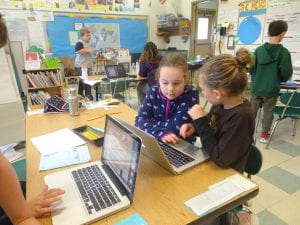 We’ve been exploring the notion of rounding. We’ve been using a number line in the classroom to make sure we’re thinking about the even 100’s or 10’s our number is in between, before deciding to round down or up. Some children are confused about this, especially when rounding down. They are rounding to the 10 or 100 beyond. For example: 523 is being rounded down to 400, rather then 500. We’ll keep practicing. I’ve been asking the children to write the amounts their number is between before rounding. It takes time, and some of them are resistant, but it helps with understanding.
We’ve been exploring the notion of rounding. We’ve been using a number line in the classroom to make sure we’re thinking about the even 100’s or 10’s our number is in between, before deciding to round down or up. Some children are confused about this, especially when rounding down. They are rounding to the 10 or 100 beyond. For example: 523 is being rounded down to 400, rather then 500. We’ll keep practicing. I’ve been asking the children to write the amounts their number is between before rounding. It takes time, and some of them are resistant, but it helps with understanding.
We’re using this skill with a Gram Challenge. In one of our math centers the children have been weighing common objects in the classroom. The children had an opportunity to weigh many different objects and to find combinations of objects that would weigh as close to 100 grams as possible. Now we have 7 days to find a combination of objects that weigh 1 kilogram. We began with a crayon. One crayon weighed 5 grams so Brady decided to place fifty crayons on the scale for an estimate of 250 grams. We’re excited to see what the next days bring.
Bits and Pieces –
- In Open Circle we’ve been discussing Positive Self Talk and how we can encourage ourselves to keep working through times of challenge and difficulty. We discussed the importance of staying positive and giving ourselves the opportunity to find a way through challenges.
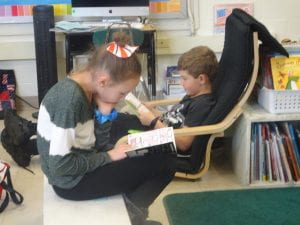 We’re thinking a lot about what is happening to the loons as we read The Mystery on Pine Lake. We’ve got a couple ideas about who is trying to get the loons to leave.
We’re thinking a lot about what is happening to the loons as we read The Mystery on Pine Lake. We’ve got a couple ideas about who is trying to get the loons to leave.- Next week, we’ll complete all of the Humphrey book clubs. It has been a real commitment. The class deserves to feel proud of their work and their attention to details and summarizing. My guess is the Humphrey will stay a favorite character for quite some time.
- Next week is our Secret Friend Celebration. Please make sure the writing and artwork are wrapped according to the assignment directions and brought to school no later then Wednesday, December 18.
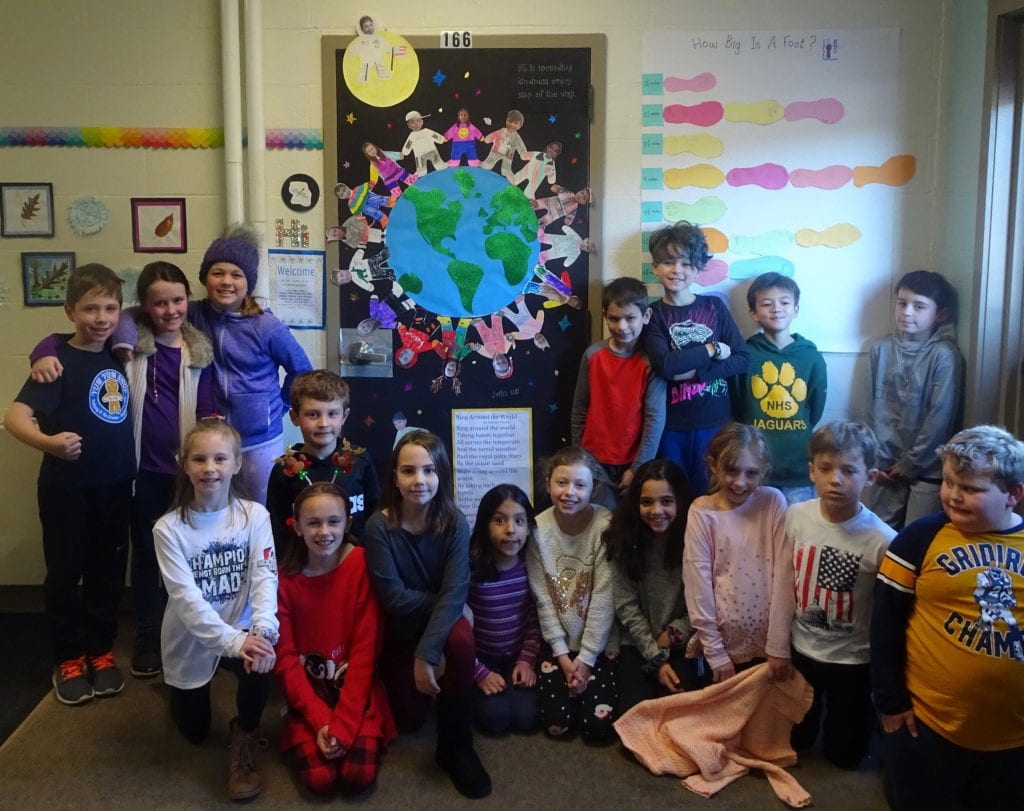
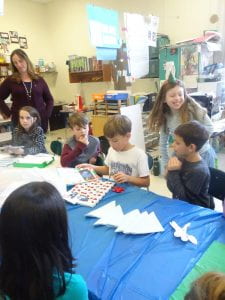
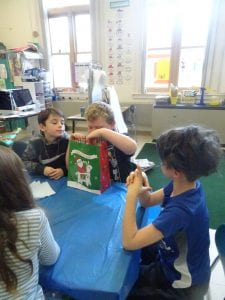


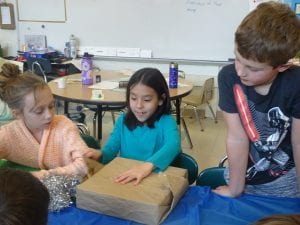

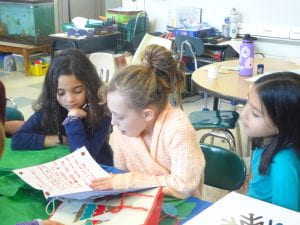


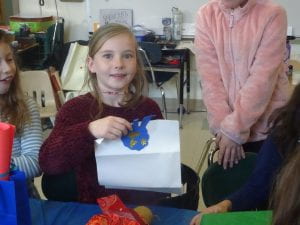

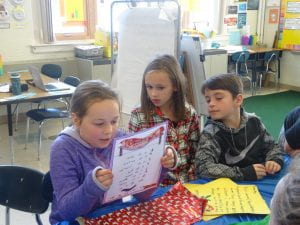
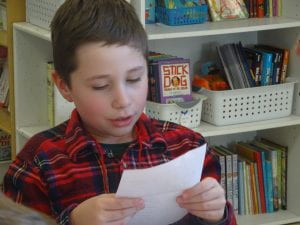

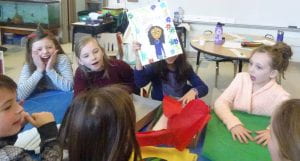

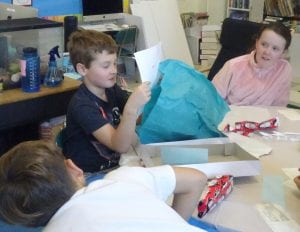
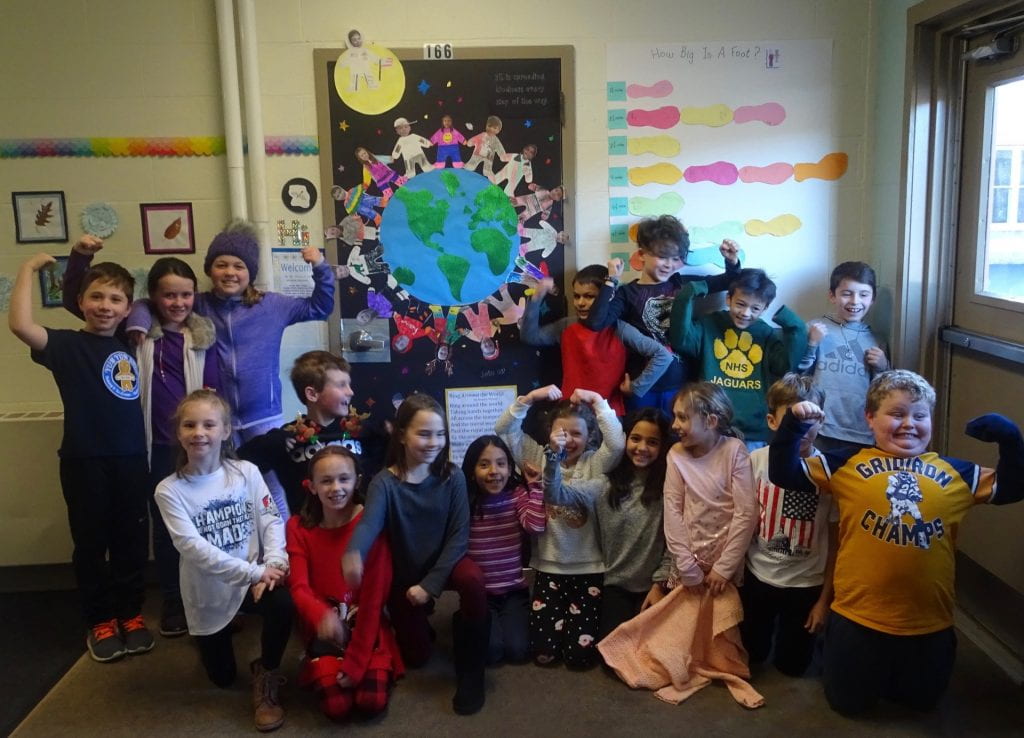
 It has been exciting to have a full week of school. It’s been a busy one. We chose a name and date for our classroom museum. We’re creating our museum displays. We’ve begun a study of global geography. We used this theme, combined with the “Choose Kind” initiative at NHS, to decorate our door – “3E is spreading kindness every step of the way.”
It has been exciting to have a full week of school. It’s been a busy one. We chose a name and date for our classroom museum. We’re creating our museum displays. We’ve begun a study of global geography. We used this theme, combined with the “Choose Kind” initiative at NHS, to decorate our door – “3E is spreading kindness every step of the way.” We also chose the date and times for this event. There was no perfect time for everyone, but we hope that with advance notice, families might be able to rearrange scheduled events so that everyone is able to attend. The class decided they could all be ready to present the information on Tuesday, January 14. We’ll have our museum open that afternoon for a dress rehearsal and then again between 5:30 and 6:15. We hope all the children will be able to attend and that families will tour the Inquiry Wonderland, asking each of the children to share what they have learned. The children will share their research and talk about what inspired them to select their topic.
We also chose the date and times for this event. There was no perfect time for everyone, but we hope that with advance notice, families might be able to rearrange scheduled events so that everyone is able to attend. The class decided they could all be ready to present the information on Tuesday, January 14. We’ll have our museum open that afternoon for a dress rehearsal and then again between 5:30 and 6:15. We hope all the children will be able to attend and that families will tour the Inquiry Wonderland, asking each of the children to share what they have learned. The children will share their research and talk about what inspired them to select their topic. When you come to the museum, you’ll see a wide variety of presentations. We’ve allowed and encouraged the children to work independently. We talked about final presentation and the need to attention to accuracy, details and conventions. Some children have been engaged throughout the whole process. They selected a topic they wanted to understand and learn more about. Others chose a topic they felt they already knew and did little new research. Some of the children have asked for teacher support for every step, while others have chosen to work with peer support. It is interesting to see how each child works through this learning process in his or her own unique way. There is a lot to attend to in a project like this and we will be able to see how they children learn from their choices when we move on to the next research project.
When you come to the museum, you’ll see a wide variety of presentations. We’ve allowed and encouraged the children to work independently. We talked about final presentation and the need to attention to accuracy, details and conventions. Some children have been engaged throughout the whole process. They selected a topic they wanted to understand and learn more about. Others chose a topic they felt they already knew and did little new research. Some of the children have asked for teacher support for every step, while others have chosen to work with peer support. It is interesting to see how each child works through this learning process in his or her own unique way. There is a lot to attend to in a project like this and we will be able to see how they children learn from their choices when we move on to the next research project. This week we explored maps. We read about them. We learned that most maps have six basic elements: keys (or legends), a compass rose, a scale, a title, labels and symbols. We tried including all of the elements (excluding scale) to create maps of our yards. Next week we’ll be using our maps to lead us into some personal narratives telling about the places we play and the stories that grow from our games and imagination.
This week we explored maps. We read about them. We learned that most maps have six basic elements: keys (or legends), a compass rose, a scale, a title, labels and symbols. We tried including all of the elements (excluding scale) to create maps of our yards. Next week we’ll be using our maps to lead us into some personal narratives telling about the places we play and the stories that grow from our games and imagination. We’ve been exploring the notion of rounding. We’ve been using a number line in the classroom to make sure we’re thinking about the even 100’s or 10’s our number is in between, before deciding to round down or up. Some children are confused about this, especially when rounding down. They are rounding to the 10 or 100 beyond. For example: 523 is being rounded down to 400, rather then 500. We’ll keep practicing. I’ve been asking the children to write the amounts their number is between before rounding. It takes time, and some of them are resistant, but it helps with understanding.
We’ve been exploring the notion of rounding. We’ve been using a number line in the classroom to make sure we’re thinking about the even 100’s or 10’s our number is in between, before deciding to round down or up. Some children are confused about this, especially when rounding down. They are rounding to the 10 or 100 beyond. For example: 523 is being rounded down to 400, rather then 500. We’ll keep practicing. I’ve been asking the children to write the amounts their number is between before rounding. It takes time, and some of them are resistant, but it helps with understanding. We’re thinking a lot about what is happening to the loons as we read
We’re thinking a lot about what is happening to the loons as we read 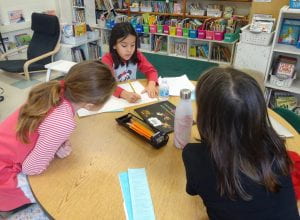 This will be a short note this week. As I write, we’ve only had two days in the classroom. We are continuing to learn about estimation, rounding. We’ve begun to learn about weighing with grams and fractions. We are continuing to research and are using our notes to create informational displays for a museum we hope to hold in early January. We are beginning to explore mapping and our world in a global geography unit.
This will be a short note this week. As I write, we’ve only had two days in the classroom. We are continuing to learn about estimation, rounding. We’ve begun to learn about weighing with grams and fractions. We are continuing to research and are using our notes to create informational displays for a museum we hope to hold in early January. We are beginning to explore mapping and our world in a global geography unit. As we make estimates, we will be learning more about place value and rounding up and down to the nearest ten and the nearest hundred. We’ve learned that to round you look at the digit to the right of the amount you are rounding and then use the rule – 5 and above round up, 4 and below round down. We’ll be developing this understanding over the next few weeks.
As we make estimates, we will be learning more about place value and rounding up and down to the nearest ten and the nearest hundred. We’ve learned that to round you look at the digit to the right of the amount you are rounding and then use the rule – 5 and above round up, 4 and below round down. We’ll be developing this understanding over the next few weeks.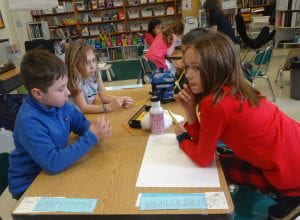 This month our calendar pattern is designed to help us discover more about fractions and equivalence. Through the pattern so far we have learned about halves, thirds, and fourths. The class has been learning a lot of about fractions in music with Mrs. Oliver too. They’ve been creating rhythms by combining whole, half, quarter and eighth notes. It’s not easy to do and takes a lot of concentration.
This month our calendar pattern is designed to help us discover more about fractions and equivalence. Through the pattern so far we have learned about halves, thirds, and fourths. The class has been learning a lot of about fractions in music with Mrs. Oliver too. They’ve been creating rhythms by combining whole, half, quarter and eighth notes. It’s not easy to do and takes a lot of concentration. In Open Circle we have been learning ways to strengthen relationships. We’ve been practicing giving and receiving compliments. We’ve been learning how to speak up for things we believe in or feel strongly about. We’ve been finding ways to share our opinions and to accept differences of opinion. Through role-playing activities we’ve learned the difference between advocating and telling – safety is a big part of our decision making process. We’ve practiced ways of being a supportive friend by encouraging and looking for the good in each person and each situation. We’ve spent time talking about what a cooperative classroom looks like, sounds like and feels like.
In Open Circle we have been learning ways to strengthen relationships. We’ve been practicing giving and receiving compliments. We’ve been learning how to speak up for things we believe in or feel strongly about. We’ve been finding ways to share our opinions and to accept differences of opinion. Through role-playing activities we’ve learned the difference between advocating and telling – safety is a big part of our decision making process. We’ve practiced ways of being a supportive friend by encouraging and looking for the good in each person and each situation. We’ve spent time talking about what a cooperative classroom looks like, sounds like and feels like.
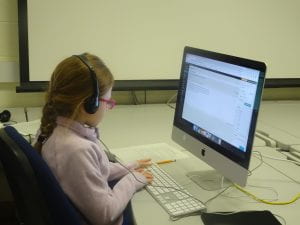
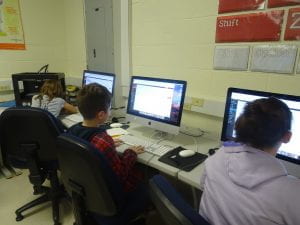 We’re finishing our Humphrey
We’re finishing our Humphrey 
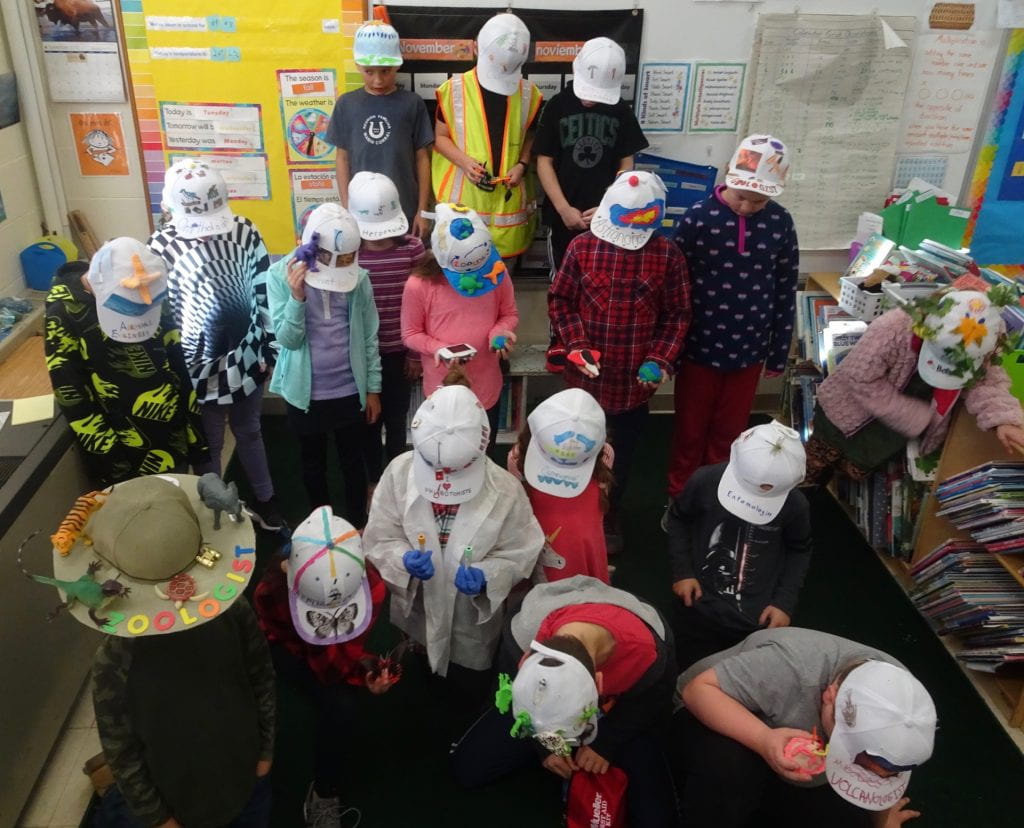 We had a wonderful day celebrating scientists and science today. First of all, thank you for your time and support of this project. The children love science! They have an open, questioning mind about the subject and an understanding of how diverse it is because of this project. The children know that “mad scientists” are fiction and, they have a strong sense of what scientists do to solve problems and to continually ask questions to lead to further discoveries. They know that one question, leads to another, and another after that.
We had a wonderful day celebrating scientists and science today. First of all, thank you for your time and support of this project. The children love science! They have an open, questioning mind about the subject and an understanding of how diverse it is because of this project. The children know that “mad scientists” are fiction and, they have a strong sense of what scientists do to solve problems and to continually ask questions to lead to further discoveries. They know that one question, leads to another, and another after that.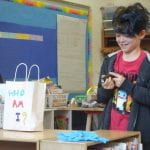
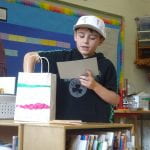
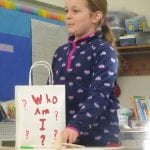

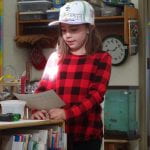
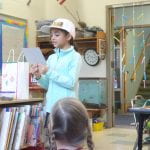

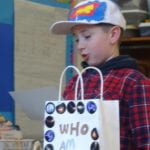
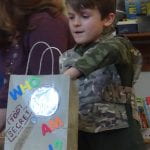
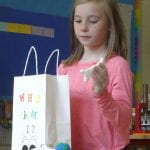



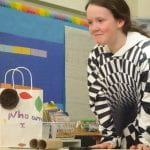

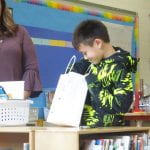
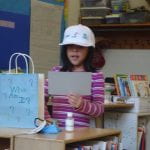
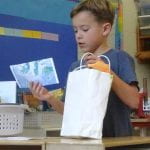
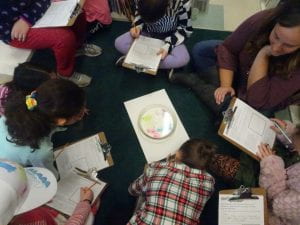


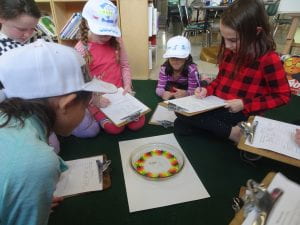
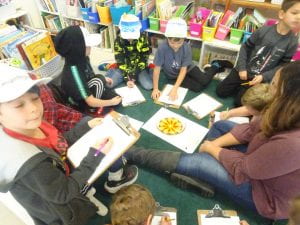
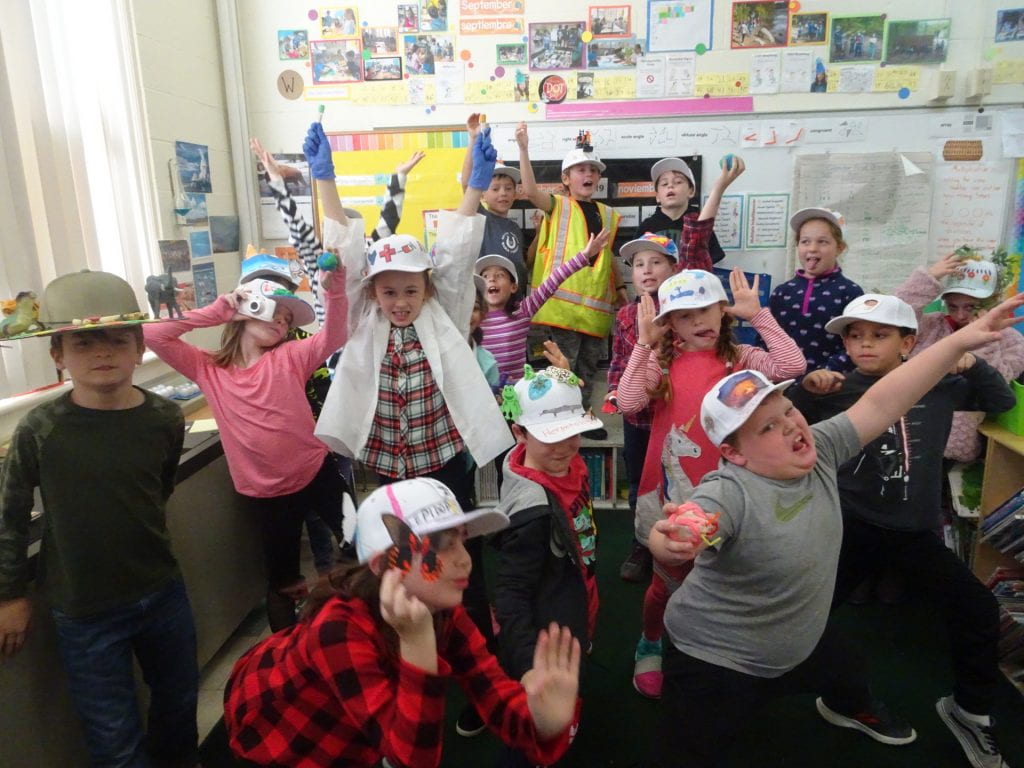
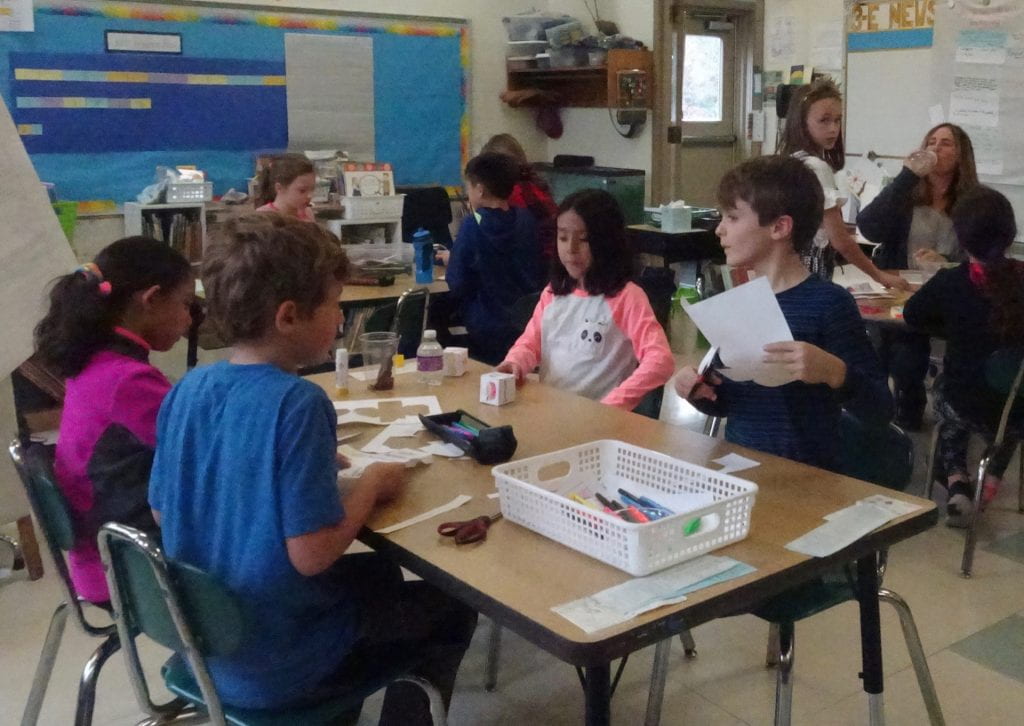
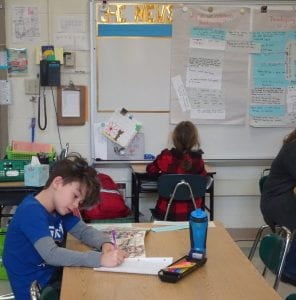 Each of the children has chosen an individual inquiry topic to research. They began by asking questions to guide their research. They’ve been exploring books and online resources as well. Some of these sources can be accessed through the school library and others can be accessed through the “Research Resources” category side bar on our blog. We are working to make sure we write our own original thoughts so we’ll be able to share our own understanding as we write and create. The children are reading a page or a section, putting the book aside, and writing a note about what they think the author was trying to teach them. It slows the research process down and helps the children think closely about what they know and understand. Several of them have finished their research and are beginning to create their writing and planning their displays.
Each of the children has chosen an individual inquiry topic to research. They began by asking questions to guide their research. They’ve been exploring books and online resources as well. Some of these sources can be accessed through the school library and others can be accessed through the “Research Resources” category side bar on our blog. We are working to make sure we write our own original thoughts so we’ll be able to share our own understanding as we write and create. The children are reading a page or a section, putting the book aside, and writing a note about what they think the author was trying to teach them. It slows the research process down and helps the children think closely about what they know and understand. Several of them have finished their research and are beginning to create their writing and planning their displays.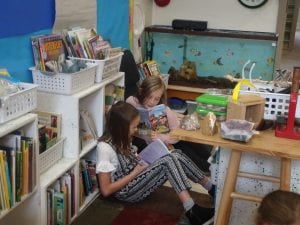 We are continuing to develop comprehension strategies in our book clubs. Our first book club choices were centered on the idea that everyone can write what they know and feel in their hearts. All of the books in the first book club picture books. The clubs were designed so that everyone could meet the expectations of 1) completing the book, 2) writing a summary, 3) selecting a favorite part to speak to and 4) to make an inference about the author’s message. All of the children met these expectations and had we some great discussions about their books and reading.
We are continuing to develop comprehension strategies in our book clubs. Our first book club choices were centered on the idea that everyone can write what they know and feel in their hearts. All of the books in the first book club picture books. The clubs were designed so that everyone could meet the expectations of 1) completing the book, 2) writing a summary, 3) selecting a favorite part to speak to and 4) to make an inference about the author’s message. All of the children met these expectations and had we some great discussions about their books and reading.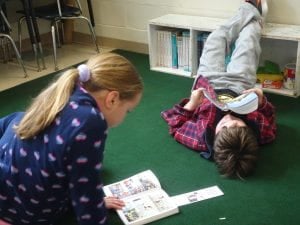 Our second book clubs selections have been all about Humphrey. We have enjoyed getting to know this character, along with more about the students in Room 26. The children have been using the Essence or the Line-A-Page strategy to keep track of the thinking as they read. We are close to the end of the books with 1, 2 or 3 chapters remaining. Some of the readers are expressing fatigue – it takes too long to write it all out – and yet they are learning that the strategies do help them then and understand. We hope to be done in early December.
Our second book clubs selections have been all about Humphrey. We have enjoyed getting to know this character, along with more about the students in Room 26. The children have been using the Essence or the Line-A-Page strategy to keep track of the thinking as they read. We are close to the end of the books with 1, 2 or 3 chapters remaining. Some of the readers are expressing fatigue – it takes too long to write it all out – and yet they are learning that the strategies do help them then and understand. We hope to be done in early December. This week we began a study of estimation. We hope to answer these questions: What is an estimate? Why do people estimate? When could we use estimation? Can we find examples where estimation is used outside of school?
This week we began a study of estimation. We hope to answer these questions: What is an estimate? Why do people estimate? When could we use estimation? Can we find examples where estimation is used outside of school? We are continuing to explore
We are continuing to explore 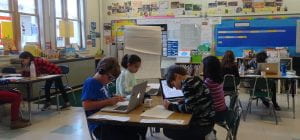 We’re reading
We’re reading 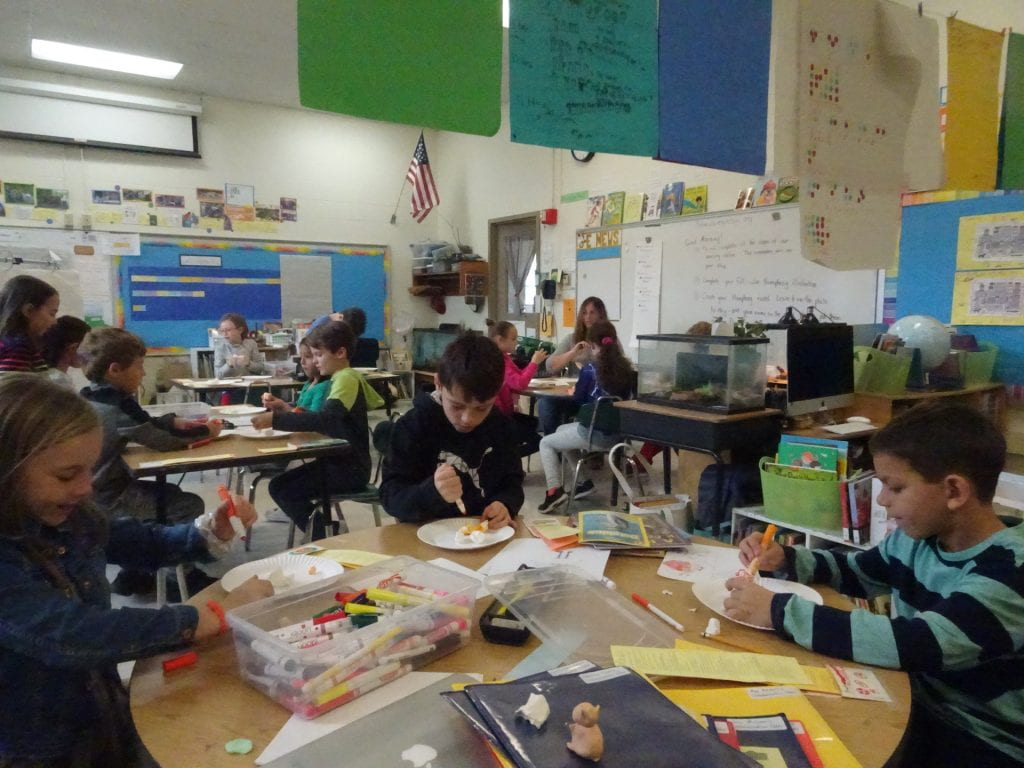 We’ve been thinking about gratitude and learning some of the history behind Thanksgiving. We finished our second Humphrey read-aloud and the Humphrey book clubs are starting to wrap up as well. We had fun creating Humphrey models and Humphrey art this week. We had a couple indoor recesses and so many in the class had the chance to build with marble works and explore magnetism – a great introduction to our next science inquiry, force and motion.
We’ve been thinking about gratitude and learning some of the history behind Thanksgiving. We finished our second Humphrey read-aloud and the Humphrey book clubs are starting to wrap up as well. We had fun creating Humphrey models and Humphrey art this week. We had a couple indoor recesses and so many in the class had the chance to build with marble works and explore magnetism – a great introduction to our next science inquiry, force and motion. We’ve spent some time learning about note taking, research and informational writing. The children have each chosen a topic to research ranging from dingoes and red pandas to Apollo 11 and galaxies. They’ve been researching in the library and online. You may want to talk to your child about the topic he or she has chosen to find out what they have discovered so far. Often talking helps uncover new questions, or will connect them to new resources and information. This independent inquiry, combined with the Who Am I? project and other classroom experiences with observation, description and guided experiments has been designed to help the children understand the nature and variety of scientific exploration. (And it’s fun.)
We’ve spent some time learning about note taking, research and informational writing. The children have each chosen a topic to research ranging from dingoes and red pandas to Apollo 11 and galaxies. They’ve been researching in the library and online. You may want to talk to your child about the topic he or she has chosen to find out what they have discovered so far. Often talking helps uncover new questions, or will connect them to new resources and information. This independent inquiry, combined with the Who Am I? project and other classroom experiences with observation, description and guided experiments has been designed to help the children understand the nature and variety of scientific exploration. (And it’s fun.)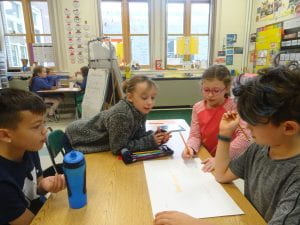 This week we’ve spent some time reading about Thanksgiving. We’ve learned some about the Pilgrims and some about New Hampshire’s role in helping Thanksgiving become a national holiday. See if you child can tell you about it. We’ve spent time considering how gratitude can help us notice how fortunate we are. Your children created a top 10 list and worked to create an acrostic poem for their blog.
This week we’ve spent some time reading about Thanksgiving. We’ve learned some about the Pilgrims and some about New Hampshire’s role in helping Thanksgiving become a national holiday. See if you child can tell you about it. We’ve spent time considering how gratitude can help us notice how fortunate we are. Your children created a top 10 list and worked to create an acrostic poem for their blog. As I prepare the first term report cards, I’d like to thank so many of you for coming to your child’s goal setting conference to hear how he or she describes his/her learning process at this point in the year. It is challenging for eight and nine year olds to reflect on learning. They each spent time to thoughtfully identify strengths and to look for areas of growth. Each of the children did a wonderful job with this process and in choosing the work to serve as evidence for their claims. Thank you, also for meeting with me to share assessment data and work samples that will help you (hopefully) better understand the report cards when you receive them.
As I prepare the first term report cards, I’d like to thank so many of you for coming to your child’s goal setting conference to hear how he or she describes his/her learning process at this point in the year. It is challenging for eight and nine year olds to reflect on learning. They each spent time to thoughtfully identify strengths and to look for areas of growth. Each of the children did a wonderful job with this process and in choosing the work to serve as evidence for their claims. Thank you, also for meeting with me to share assessment data and work samples that will help you (hopefully) better understand the report cards when you receive them. Because of our conferences, this term’s report card will not have an extensive narrative comment – those will come with terms two and three. If you find you have questions and concerns, please don’t hesitate to ask. If you’ve not been able to schedule a conference, please let me know if you would like to meet.
Because of our conferences, this term’s report card will not have an extensive narrative comment – those will come with terms two and three. If you find you have questions and concerns, please don’t hesitate to ask. If you’ve not been able to schedule a conference, please let me know if you would like to meet. Finally, it would be greatly appreciated if you could find time to talk with your child about what it means at your house to put forth one’s best effort. Each child understands our classroom discussions differently. For some children, it seems, working fast is best. That means they skim across the activities doing what they already know rather than extending themselves to learn “new”. As a result, expectations are only partially met. For other children it seems as though assignments are secondary, being social comes first. Conversation consumes their time. They approach tasks as if they can get them done eventually. As a result of these choices, expectations are seldom met. The children simply run out of time. Some children lack confidence. They are not sure they’ll succeed, and so not trying feels like a safer option. We’ve been talking about positive self-talk and growth mindset. All of the children need support with organizing, prioritizing and managing time. They will benefit from finding ways to listen to their positive inner voice as they explore ideas and find opportunities for learning in all they do whether simple or complex. Thank you for your help in exploring these ideas with your child. It will be exciting to see how learning grows in 3E.
Finally, it would be greatly appreciated if you could find time to talk with your child about what it means at your house to put forth one’s best effort. Each child understands our classroom discussions differently. For some children, it seems, working fast is best. That means they skim across the activities doing what they already know rather than extending themselves to learn “new”. As a result, expectations are only partially met. For other children it seems as though assignments are secondary, being social comes first. Conversation consumes their time. They approach tasks as if they can get them done eventually. As a result of these choices, expectations are seldom met. The children simply run out of time. Some children lack confidence. They are not sure they’ll succeed, and so not trying feels like a safer option. We’ve been talking about positive self-talk and growth mindset. All of the children need support with organizing, prioritizing and managing time. They will benefit from finding ways to listen to their positive inner voice as they explore ideas and find opportunities for learning in all they do whether simple or complex. Thank you for your help in exploring these ideas with your child. It will be exciting to see how learning grows in 3E.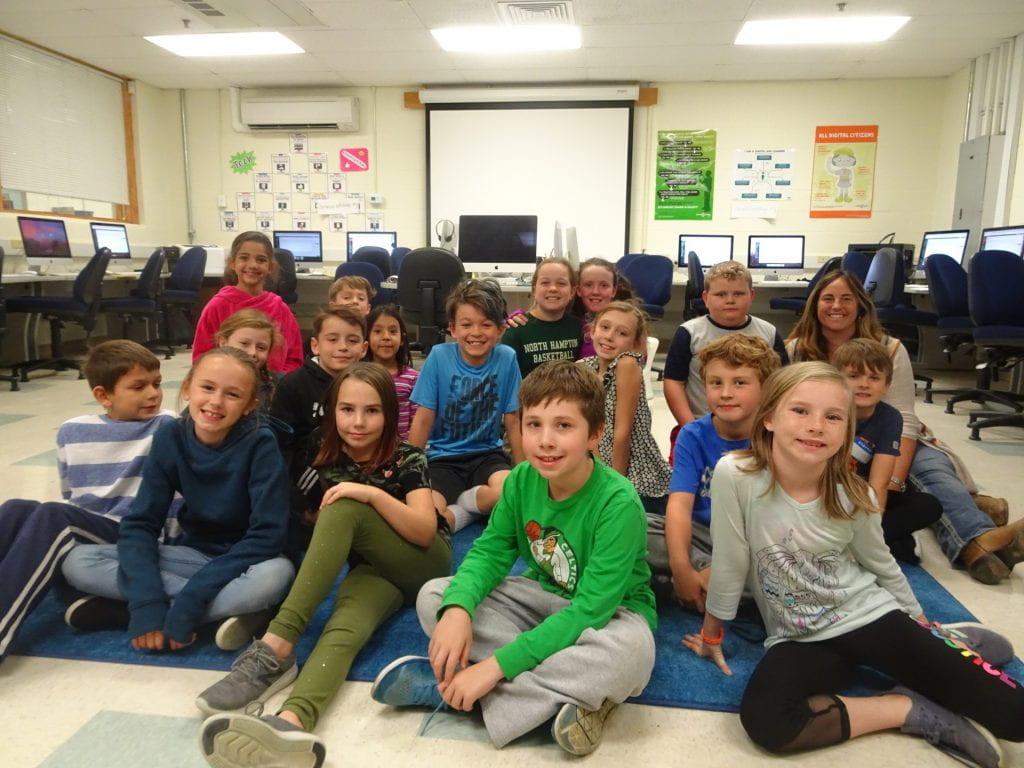 I’ve enjoyed following the student-led goal setting conferences with the parent-teacher conferences this week. Thank you for your time and your interest in how we can work together to create a third grade that feels engaging for each unique member of our learning community.
I’ve enjoyed following the student-led goal setting conferences with the parent-teacher conferences this week. Thank you for your time and your interest in how we can work together to create a third grade that feels engaging for each unique member of our learning community.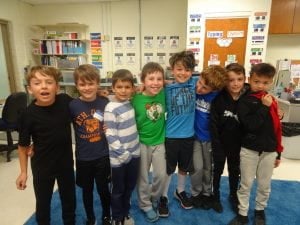 Throughout the week we’ve explore kindness, curiosity, note taking, learning about and using comprehension strategies for reading nonfiction and fiction.
Throughout the week we’ve explore kindness, curiosity, note taking, learning about and using comprehension strategies for reading nonfiction and fiction.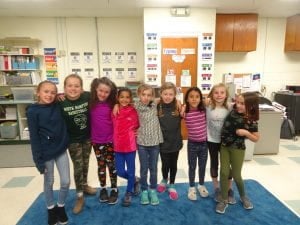 This week we’ve read books and held discussions centered on kindness each day. We’ve explored what it looks like, what it feels like and what it sounds like. We’ve talked about coping with disappointment and dealing with frustration. We’ve talked about how fairness and honesty play a part in kindness. We learned the difference between being a bystander and an up-stander who advocates for others when there is an imbalance of power. We are all trying to live up to our own expectations – it is easy to talk and write about kindness. It is not always easy to act with kindness in the classroom or on the playground but we’ll keep trying and doing all we can to grow.
This week we’ve read books and held discussions centered on kindness each day. We’ve explored what it looks like, what it feels like and what it sounds like. We’ve talked about coping with disappointment and dealing with frustration. We’ve talked about how fairness and honesty play a part in kindness. We learned the difference between being a bystander and an up-stander who advocates for others when there is an imbalance of power. We are all trying to live up to our own expectations – it is easy to talk and write about kindness. It is not always easy to act with kindness in the classroom or on the playground but we’ll keep trying and doing all we can to grow.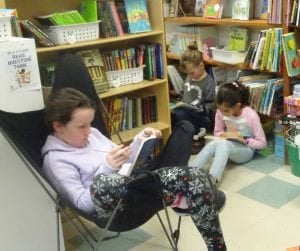 We’ve learned three different strategies for tracking our understanding: Sketch to Stretch, Essence – identifying the main idea, and A Line A Page. One of the things the kids have noticed is that taking time to write slows them down. At first this was a bother, but now most of the children recognize how stopping to think and write truly does help them understand and remember more of what they are reading. We’re having fun with the Humphrey book clubs. Humphrey and Og are inspiring classroom pets. We are looking forward to celebrating the completion of our clubs by making models of Humphrey, writing reviews and creating illustrations of our favorite parts of the books we have been reading.
We’ve learned three different strategies for tracking our understanding: Sketch to Stretch, Essence – identifying the main idea, and A Line A Page. One of the things the kids have noticed is that taking time to write slows them down. At first this was a bother, but now most of the children recognize how stopping to think and write truly does help them understand and remember more of what they are reading. We’re having fun with the Humphrey book clubs. Humphrey and Og are inspiring classroom pets. We are looking forward to celebrating the completion of our clubs by making models of Humphrey, writing reviews and creating illustrations of our favorite parts of the books we have been reading.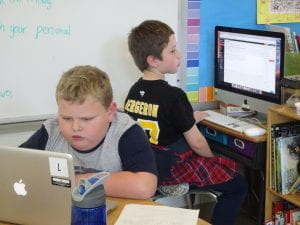 We’ve been exploring curiosity. What is curiosity? When is it a good thing and how can we grow it? When is it a strength? How can it power learning and discovery? We’ve launched an independent inquiry. The children have each chosen their own topic and are in the process of questioning, reading, researching and wondering more. Their first step was to a choose topic they each had a lot of questions about. Then they began to explore our resources – both print and online – to see if they could find information that helped us answer their questions and that sparked more. Some of the children realized they needed to change their topic and others have realized they needed to narrow and refine their topic so it became more manageable.
We’ve been exploring curiosity. What is curiosity? When is it a good thing and how can we grow it? When is it a strength? How can it power learning and discovery? We’ve launched an independent inquiry. The children have each chosen their own topic and are in the process of questioning, reading, researching and wondering more. Their first step was to a choose topic they each had a lot of questions about. Then they began to explore our resources – both print and online – to see if they could find information that helped us answer their questions and that sparked more. Some of the children realized they needed to change their topic and others have realized they needed to narrow and refine their topic so it became more manageable. We had the opportunity to plant garlic this week. Garlic is an interesting crop because you plant it in the fall and harvest it in the spring. We had a digital gram scale so the children know the weight of the clove they planted. In May we will compare it to see how it has grown. We are hoping for a successful harvest in May.
We had the opportunity to plant garlic this week. Garlic is an interesting crop because you plant it in the fall and harvest it in the spring. We had a digital gram scale so the children know the weight of the clove they planted. In May we will compare it to see how it has grown. We are hoping for a successful harvest in May.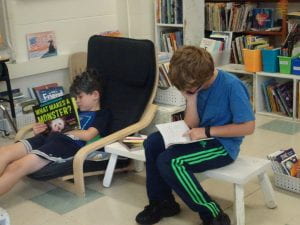 The class has been excited about the Who Am I? Scientist Project. We appreciate your support with that. The identification cards and hat blueprints are due on Tuesday, November 12. That is the day the hats and blank bags will be sent home so the children will have a full week to get that portion of the project completed.
The class has been excited about the Who Am I? Scientist Project. We appreciate your support with that. The identification cards and hat blueprints are due on Tuesday, November 12. That is the day the hats and blank bags will be sent home so the children will have a full week to get that portion of the project completed.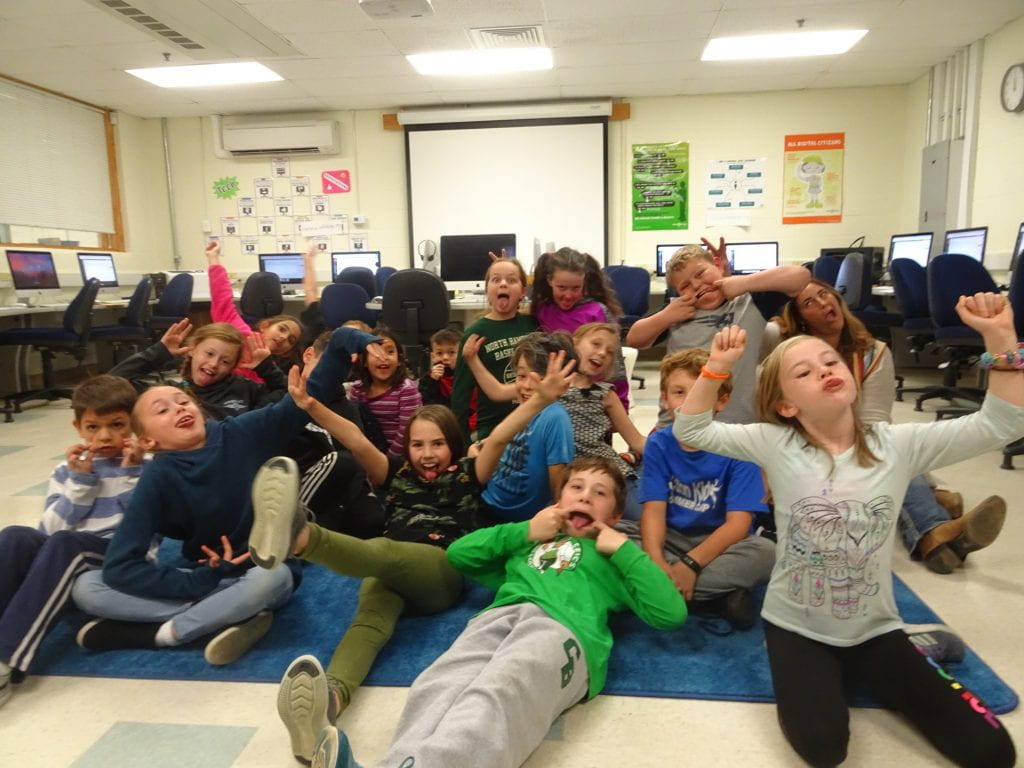
 As we begin this new inquiry project here are some tips that could help you find the information you are looking for.
As we begin this new inquiry project here are some tips that could help you find the information you are looking for.  Remember to read each section and article carefully and take notes paragraph by paragraph. Have fun on your search.
Remember to read each section and article carefully and take notes paragraph by paragraph. Have fun on your search.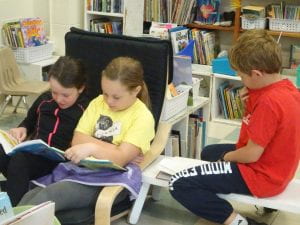 It’s been a busy weeks. The math stations seem to be working well, blogging continues to be exciting – thank you for all the comments and for sharing the blogging address so widely, and we’ve begun our second set of book clubs which is great, great, great.
It’s been a busy weeks. The math stations seem to be working well, blogging continues to be exciting – thank you for all the comments and for sharing the blogging address so widely, and we’ve begun our second set of book clubs which is great, great, great.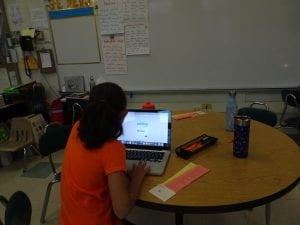 This week our S.E.L. discussions have focused on the definition of bullying and how we can take care with our words. We’ve practiced being encouraging, complimentary and caring. We’ve talked about reading reactions and apologizing. We’ve read several different books, Say Something, Just Kidding, Red, and Poetreeto help us imagine different situations and to remind us of things that happen around us each day that we might make better. We’ve discussed advocating for our selves and others. We’ve begun to explore what it means to be an up-stander.
This week our S.E.L. discussions have focused on the definition of bullying and how we can take care with our words. We’ve practiced being encouraging, complimentary and caring. We’ve talked about reading reactions and apologizing. We’ve read several different books, Say Something, Just Kidding, Red, and Poetreeto help us imagine different situations and to remind us of things that happen around us each day that we might make better. We’ve discussed advocating for our selves and others. We’ve begun to explore what it means to be an up-stander.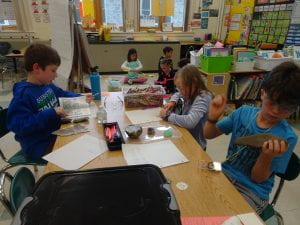 Our goal in daily problem solving is to offer the children opportunities to practice logical thinking and to find ways to use new knowledge to become more efficient over time. The children choose a strategy they can use to document their thinking and follow through to an accurate solution. This can be challenging. When you and I read the problems, we see that most of them can be solved with multiplication, but because it is still new to your children, it is not always their choice.
Our goal in daily problem solving is to offer the children opportunities to practice logical thinking and to find ways to use new knowledge to become more efficient over time. The children choose a strategy they can use to document their thinking and follow through to an accurate solution. This can be challenging. When you and I read the problems, we see that most of them can be solved with multiplication, but because it is still new to your children, it is not always their choice.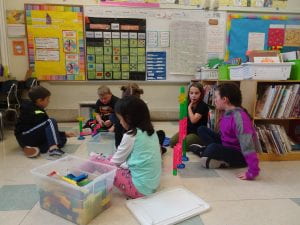 We’ve spent some time understanding the ARRAY model of multiplication. The class has learned about the commutative property. We are sure that 6×7=7×6 even if we are not instantly sure of the answer. On top of that we can create an array of that amount and find a way to solve it (We know how to 7 fives and then we just need to add one more on. Or we could double 6 three times and add one more.) It is interesting to discover there are many correct ways to reach a solution.
We’ve spent some time understanding the ARRAY model of multiplication. The class has learned about the commutative property. We are sure that 6×7=7×6 even if we are not instantly sure of the answer. On top of that we can create an array of that amount and find a way to solve it (We know how to 7 fives and then we just need to add one more on. Or we could double 6 three times and add one more.) It is interesting to discover there are many correct ways to reach a solution.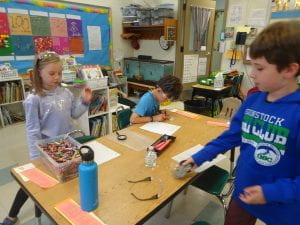 We are still trying to find out why Mrs. Brisbane is away from here class in Room 26. Humphrey’s been collecting clues and we have too. We’re having fun reading Mysteries According to Humphrey.
We are still trying to find out why Mrs. Brisbane is away from here class in Room 26. Humphrey’s been collecting clues and we have too. We’re having fun reading Mysteries According to Humphrey.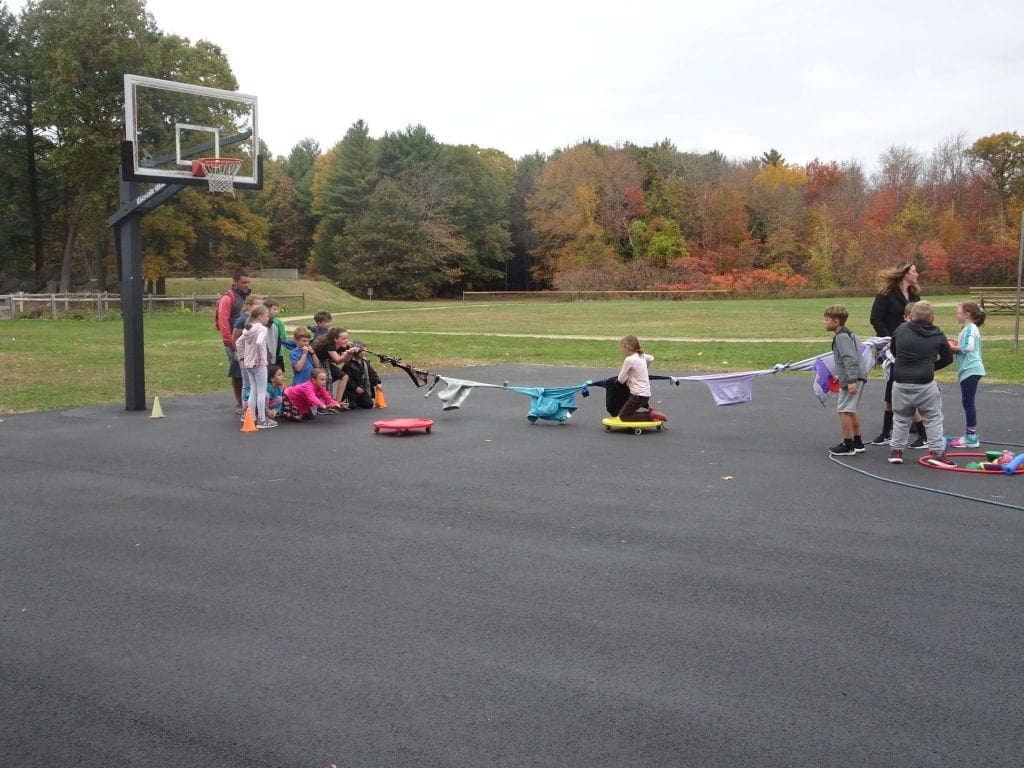 This week we’ve begun to think more about science and what scientists do. We’ve continued to explore writing with more elaborate, descriptive sentences and we’ve begun a new math center routine. We are struggling to keep a calm classroom that helps everyone do his or her best. We’ll keep working on this until we are all able to do the right thing at the right time.
This week we’ve begun to think more about science and what scientists do. We’ve continued to explore writing with more elaborate, descriptive sentences and we’ve begun a new math center routine. We are struggling to keep a calm classroom that helps everyone do his or her best. We’ll keep working on this until we are all able to do the right thing at the right time.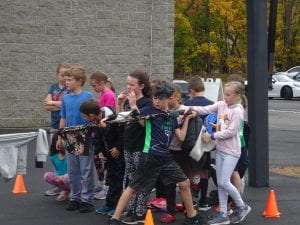 Thank you for taking time for meeting with your children and giving them the chance to present themselves as early third grade learners. It has been wonderful to see how they were able to take charge of their own learning and share how they see themselves as learners, readers, writers and mathematicians at this point in the school year.
Thank you for taking time for meeting with your children and giving them the chance to present themselves as early third grade learners. It has been wonderful to see how they were able to take charge of their own learning and share how they see themselves as learners, readers, writers and mathematicians at this point in the school year.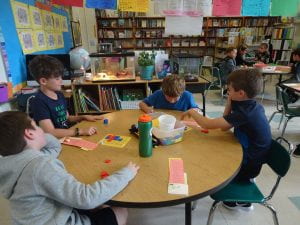 This week, in order to reduce time at the rug, we have begun math centers. The children are learning about the different models and properties of multiplication. I think everyone recognizes that the first number in a multiplication sentence represents the number of groups and the second represents the amount repeated in each group. But this week the children learned about the commutative property of multiplication so they know that they opposite equation has the same product. 3 x 5 =5 x 3. It seems as though the class fully understands the concept of multiplication.
This week, in order to reduce time at the rug, we have begun math centers. The children are learning about the different models and properties of multiplication. I think everyone recognizes that the first number in a multiplication sentence represents the number of groups and the second represents the amount repeated in each group. But this week the children learned about the commutative property of multiplication so they know that they opposite equation has the same product. 3 x 5 =5 x 3. It seems as though the class fully understands the concept of multiplication.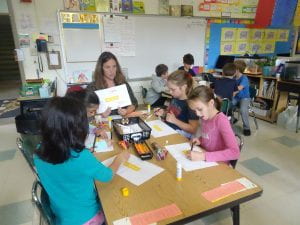 We’ve been reading about science and about the habits of scientists. Here’s the way we completed “Science is…”: cool, experimenting, a discovery, asking why, when, where and how, interesting, fun to do, math, an adventure, trying new things, exciting, biology, geology, astronomy, drawing, finding our about cool animals, always new, amazing, writing, and inspiring. We’ve learned that scientists ask a lot of questions. The children are each choosing a science topic they have lots of questions about. They’ll spend some time researching their topic and then find a way to teach others what they’ve learned.
We’ve been reading about science and about the habits of scientists. Here’s the way we completed “Science is…”: cool, experimenting, a discovery, asking why, when, where and how, interesting, fun to do, math, an adventure, trying new things, exciting, biology, geology, astronomy, drawing, finding our about cool animals, always new, amazing, writing, and inspiring. We’ve learned that scientists ask a lot of questions. The children are each choosing a science topic they have lots of questions about. They’ll spend some time researching their topic and then find a way to teach others what they’ve learned. Our goal is to create a new post each week, so keep checking. Share the class website with family and friends and encourage everyone to comment. The kids thrive on knowing they’re being read. It is very motivating.
Our goal is to create a new post each week, so keep checking. Share the class website with family and friends and encourage everyone to comment. The kids thrive on knowing they’re being read. It is very motivating.